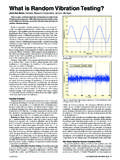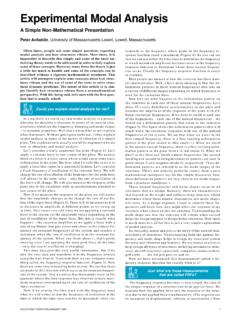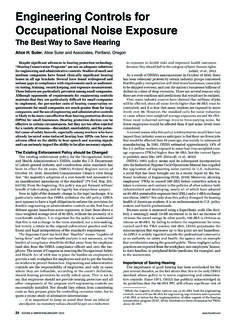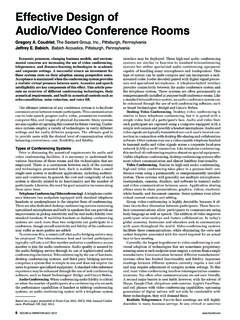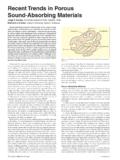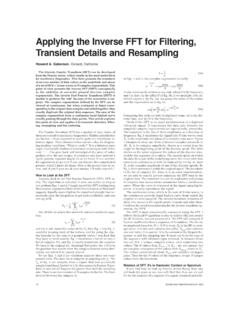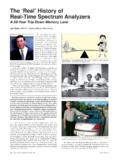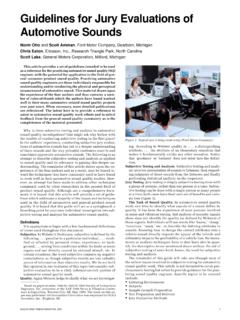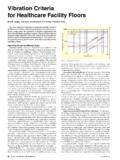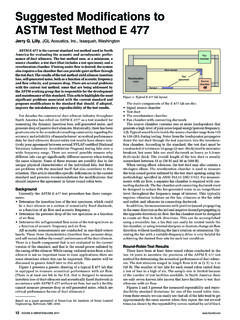Transcription of Experimental Modal Analysis of Civil Engineering …
1 12 SOUND AND VIBRATION/JUNE 2006 Experimental Modal Analysis ofCivil Engineering Structures lvaro Cunha and Elsa Caetano, University of Porto (FEUP), PortugalThis article presents the evolution of Experimental modalanalysis in the Civil Engineering field, from input-output tooutput-only Modal identification techniques. Many case his-tories are included from the experiences of the authors at theLaboratory of Vibrations and Monitoring at the University ago, a major concern of structural engineers was thedevelopment and application of new and powerful numericalmethods for the static and dynamic Analysis of large Civil en-gineering structures. The rapid development of finite-elementtechniques accompanied by tremendous technological progressin the field of personal computers allowed structural design-ers to use software packages for accurate simulation of struc-tural , the design and construction of more and morecomplex and ambitious Civil structures, like dams, large cable-stayed or suspension bridges, or other special structures haveled structural engineers to develop new Experimental tools toenable the accurate identification of the most relevant staticand dynamic properties.
2 These tools would provide reliabledata to support calibrating, updating, and validating of struc-tural Analysis numerical models used at the design continuous ageing and subsequent structural deteriora-tion of a large number of existing structures have encouragedthe development of efficient vibration-based damage detectiontechniques supported by structural health monitoring natural tendency of Civil Engineering researchers was toutilize well established input-output Modal identification tech-niques to accurately identify the main dynamic properties ofcivil , it is difficult to excite large Civil structures in a con-trolled manner. Fortunately, remarkable technological progressin transducers and analog-to-digital converters has supportedmodal Analysis of large structures exclusively based on mea-suring the structural response to ambient excitations and ap-plying suitable stochastic Modal identification main purpose of this article is to briefly present our per-spective concerning the evolution of Experimental modalanalysis in the Civil Engineering field, from input-output tooutput-only Modal identification techniques.
3 This discussionis strongly influenced by our experience as Modal IdentificationEquipment and Test Procedures. Conventional Modal test-ing is based on estimating a set of frequency response functions(FRFs) relating the applied force and corresponding responseat several pairs of points along the structure with enough highspatial and frequency resolution. The construction of FRFs re-quires use of an instrumentation chain for structural excitation,data acquisition, and signal small and medium-size structures, the excitation can beinduced by an impulse hammer (Figure 1a) similar to thosecurrently used in mechanical Engineering . This device has theadvantage of providing a wide-band input that is able to stimu-late different modes of vibration. The main drawbacks are therelatively low frequency resolution of the spectral estimates(which can preclude the accurate estimation of Modal damp-ing factors) and the lack of energy to excite some relevantmodes of vibration.
4 Due to this problem, some laboratories havebuilt special impulse devices specifically designed to excitebridges (Figure 1d). An alternative, also derived from mechani-cal Engineering , is the use of large electrodynamic shakers (Fig-ure 1c), which can apply a large variety of input signals (ran-dom, multi-sine, etc.) when duly controlled both in frequencyand amplitude using a signal generator and a power shakers have the capacity to excite structures in a lowerfrequency range and higher frequency resolution. The possi-bility of applying sinusoidal forces allows for the excitation ofthe structure at resonance frequencies and, consequently, fora direct identification of mode controlled excitation of large Civil Engineering structuresrequires the use of heavy excitation equipment. One optionfrequently used in the past in dynamic testing of dams was theeccentric mass vibrator (Figure 1b), which enables the appli-cation of sinusoidal forces with variable frequency and ampli-tude.
5 The main drawbacks of this technique are low force am-plitude induced at low frequencies, some difficulty inmeasuring the applied force, and restraining relative movementof the vibrator with regard to the structure . A better option, interms of providing a wide-band excitation over the most inter-esting frequency range for large Civil structures, is the use ofservo-hydraulic shakers. For example, Figure 2 shows twoshakers of this type built at EMPA to excite bridges or damsBased on a paper presented at the first International Modal AnalysisConference, IOMAC, Copenhagen, Denmark, April 1. (a) Impulse hammer; (b) eccentric mass vibrator; (c) electro-dynamic shaker over three load cells; d) impulse excitation device forbridges ( Leuven).13 SOUND AND VIBRATION/JUNE 2006vertically and laterally, as well as an electro-hydraulic massreaction shaker from Arsenal dynamic response of a structure is usually measuredwith accelerometers piezoelectric, piezoresistive, capacitiveor force balance,1 due to their relatively low cost and high sen-sitivity (see Figure 3).
6 A particular characteristic of piezoelec-tric accelerometers is that they don t need a power supply andoperate well over a wide frequency range. However, most arenot suited to low-frequency applications. On the contrary,piezoresistive, capacitive, and force-balance accelerometerscan provide DC or low-frequency response capability. The elec-trical signals generated by these transducers are usually ratherlow and must be amplified by conditioning units that may alsoprovide anti-aliasing, low-pass filtering (allowing lower sam-pling rates), and analog integration to velocities or data acquisition and storage of dynamic data requiresthe use of an analog-to-digital (A/D) converter in the measure-ment chain. Raw data must be initially analyzed and processed;considering operations of scale conversion, trend removal, anddecimation.
7 Subsequently, the acceleration time history can bemultiplied by appropriate time windows (Hanning, Cosine-Taper, etc.), to reduce leakage effects, and subdivided into dif-ferent blocks for evaluation of average spectral, auto spectral,and cross spectral estimates using the FFT algorithm. Finally,FRFs (frequency response functions) can be obtained using es-timators H1 or The automatic evaluation of FRFs requiresappropriate software for Analysis and signal processing, whichis already available in commercial Fourier analyzers. Theseanalyzers are sometimes implemented by a laptop PCMCIA card to allow either the acquisition of data through input chan-nels or the control of a shaker through an output Modal Identification Methods. There is a widevariety of input-output Modal identification methods whoseapplication relies either on estimates of a set of FRFs or on thecorresponding impulse response functions (IRFs), which canbe obtained through the inverse Fourier transform.
8 These meth-ods attempt to perform some fitting between measured andtheoretical functions and employ different optimization pro-cedures and different levels of simplification. Accordingly,they are usually classified according to the following criteria: Domain of application (time or frequency) Type of formulation (indirect or Modal and direct) Number of modes analyzed (SDOF or MDOF single degreeof freedom or multi degree of freedom) Number of inputs and type of estimates (SISO, SIMO, MIMO,MISO single input single output, single input multi out-put, multi input multi output, multi input single output).Early methods of identification were developed for the fre-quency domain. For simple SDOF formulations (peak ampli-tude, curve-fit, inverse methods, for example), the fit betweena measured and a theoretical FRF of a SDOF system in the vi-cinity of each resonant frequency is developed; neglecting thecontribution of resonant modes.
9 In more sophisticated MDOF methods rational fraction polynomial (RFP), complex expo-nential frequency domain (CEFD), polyreference frequencydomain (PRFD) the fit between measured and theoreticalFRFs is made globally for a wide range of methods, which tend to provide the best resultswhen a large frequency range or a large number of modes existin the data, were developed because of limitations in the fre-quency resolution of spectral estimates and leakage errors inthe estimates. The most widely known methods are either in-direct complex exponential (CE), least-squares complex ex-ponential (LSCE), polyreference complex exponential (PRCE),Ibrahim time domain (ITD), eigen system realization algorithm(ERA), or direct autoregressive moving-average (ARMA).The gradual development of all these methods, which are ex-tensively described by Maia, et al,1 tend to be completely au-tomated systems of acquisition, Analysis , processing, and iden-tification, instead of interactive programs initially.
10 Beyond that,the best-performing methods have been implemented in robustmodal Analysis A special class of Modal identificationmethods, called tuned-sinusoidal methods ( Asher, Mau) cor-responds to the particular type of tests that are based on the ap-plication of a sinusoidal excitation at each natural frequency,which can be implemented using eccentric mass of Forced Vibration Tests. The performance ofclassical input-output Modal identification tests in Civil engi-neering structures can be of interest both for physical modelsand for prototypes. Figures 4 and 5 show a physical model ofJindo Bridge (South Korea), which was extensively tested toanalyze the importance of dynamic cable- structure interactionsin terms of seismic response Several forced vibra-Figure 2. Servo-hydraulic shakers to excite: (a) bridges, vertically; (b)electro-hydraulic shaker from Arsenal Research; (c) dams, laterally(EMPA).
